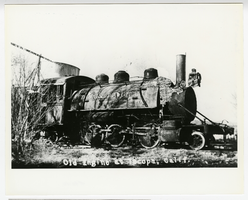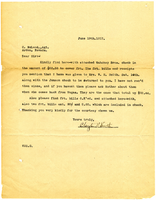Search the Special Collections and Archives Portal
Search Results

Letter from W. E. Smith to C. McLeod, May 30, 1913
Date
Archival Collection
Description
Text

Letter to C. McLeod, May 15, 1913
Date
Archival Collection
Description
Text

Photograph of the Tecopa Railroad Engine No. 1, Tecopa (Nev.), 1920
Date
Archival Collection
Description
Caption: Old Engine at Tecopa, Calif.
Image

Letter from J. G. Scrugham to F. R. McNamee, March 2, 1923
Date
Archival Collection
Description
Text

Letter from W. E. Smith to C. McLeod, June 10, 1913
Date
Archival Collection
Description
Text
Clarence Ray oral history interview
Identifier
Abstract
Oral history interview with Clarence Ray conducted by Eleanor L. Walker in 1991 for the African American in Las Vegas: a Collaborative Oral History Project. In this interview, Ray provides details of his ancestry and upbringing, his education, and race relations in the western United States before 1930. He then moves on to his first visit to Las Vegas, Nevada in 1922, and his movements before settling permanently in the 1940s. He explains that the main source of employment for the relatively small Black population during the 1920s and early 1930s was the railroad, but a number were also in business. Mr. Ray provides thumbnail sketches of many of the early residents, and is particularly informative about "Mammy" Pinkston, Mary Nettles, the Stevens family, and the Ensley family. Systemic racial discrimination against Blacks developed in southern Nevada during the 1930s, and Mr. Ray provides some useful details on this along with his discussion of his career in gaming and his social and political activities.
Archival Collection

Letter from Clayton V. Smith to C. McLeod, June 19, 1913
Date
Archival Collection
Description
Text

Letter from W. E. Smith to C. McLeod, June 11 [1913]
Date
Archival Collection
Description
Text
Fred and Maurine Wilson Photograph Collection
Identifier
Abstract
The Fred and Maurine Wilson Photograph Collection depicts the Wilson Family, events, and locations in Las Vegas, Nevada and the Southwestern United States from approximately 1860 to 1990. The photographs primarily depict early Las Vegas, including the Mormon Fort and Kiel Ranch; mines, towns, and railroads in Southern Nevada; the construction and planning of the Hoover (Boulder) Dam on the Colorado River; and the Wilson Family. The photographs also include prominent Las Vegas families such as the Park Family, aerial photographs of the city, landmarks on Fremont Street and downtown Las Vegas, and desert landscapes.
Archival Collection

Letter from J. T. McWilliams to J. Ross Clark, November 9, 1902
Date
Archival Collection
Description
Text
